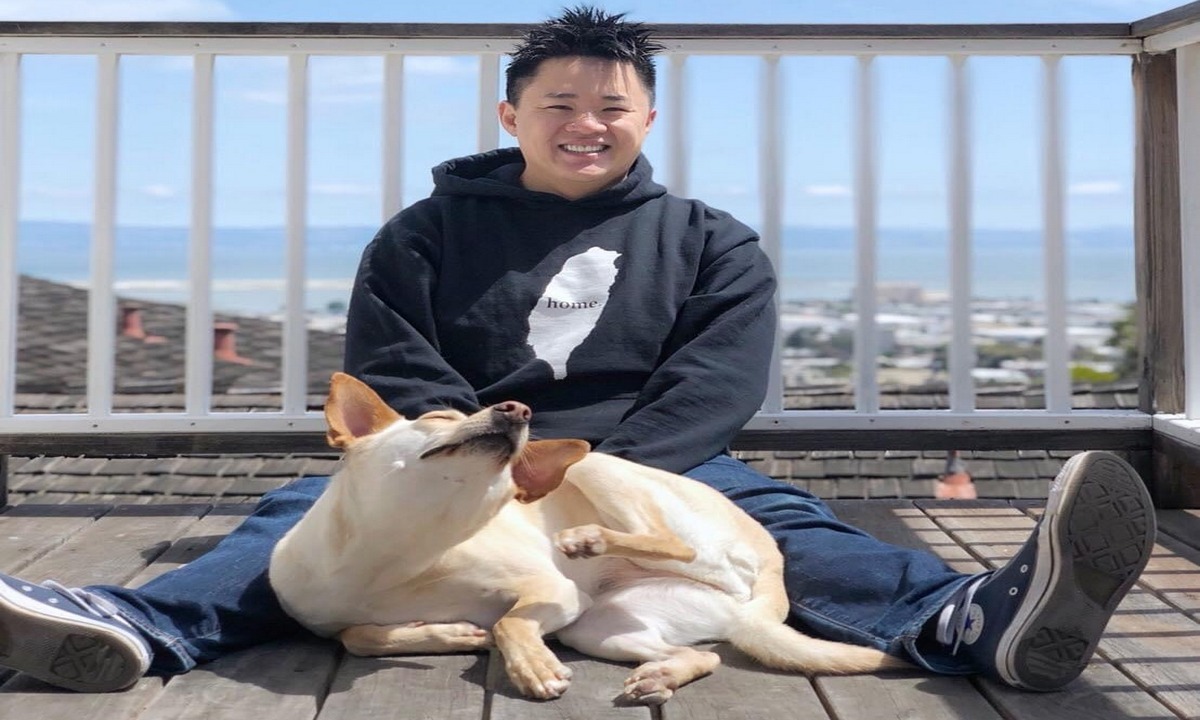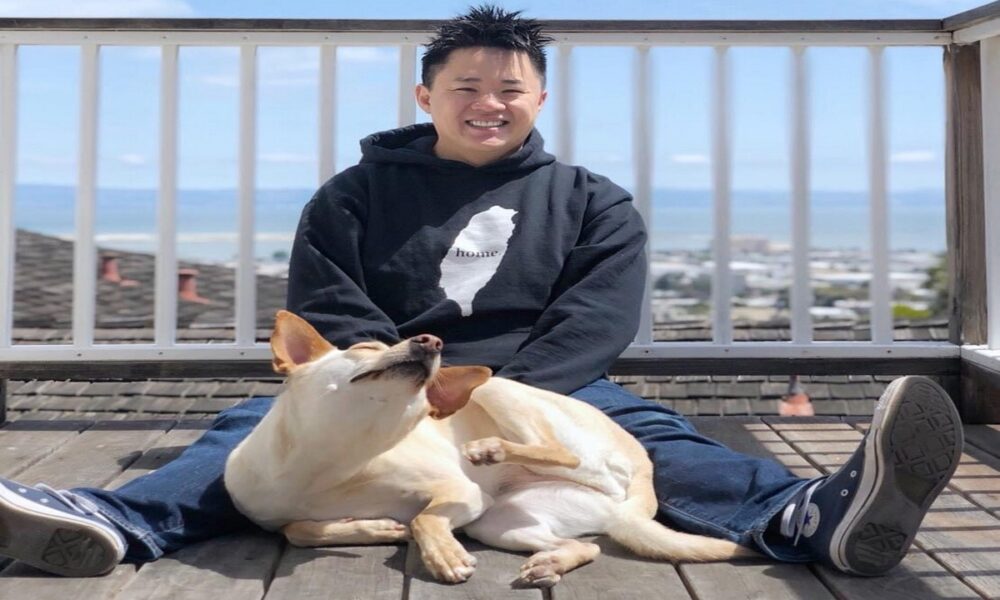July 2023 KPA CTP of the Month

Interpreting the stray dogs as signs or messengers, Philip was reminded that he had always wanted a dog. He realized that his life, housing, financial, and time commitments and circumstances were, finally, aligned perfectly and that his current location, San Francisco, was extremely pet-friendly. Philip’s childhood dream of having a pet grew into daydreams of potential dog-related careers.
Philip decided that the responsible next step was to learn more about dogs! He contacted a friend from his high school in Taiwan who was a KPA CTP; she recommended the KPA Dog Trainer Foundations course and Philip enrolled. Halfway through the course, “and feeling the good vibes building,” Philip began the search for his dog. Broadening his search from local shelters to international rescues, and after a few false starts, Philip found Alisa who had come from Taiwan, too!
It was “love at first sight” when Philip met Alisa with “her ridiculously large ears.” Although Philip was told that Alisa was shy and fearful, she seemed comfortable with Philip, who took her home and began applying what he had learned from the KPA Foundations course. “It felt like pure magic. While Alisa was indeed quite sensitive to a variety of stimuli, I was well prepared to counter-condition her and help alleviate her stress.” Philip reports that, “before KPA, I had never heard of positive reinforcement, but I watched Alisa's eyes light up each time we had a training session. She would run to the rug where we practiced and sit with her tail wagging, as if she were telling me, ‘I’m ready, teacher!’” Philip’s visiting mom, a piano teacher, concurred, saying, “This dog really, really loves to learn!”
With such a strong start, Philip began to wonder. “If a foundational course could offer so much and advance us so far, what would an advanced program do?” He signed up for the KPA Dog Trainer Professional (DTP) program to continue his “life-changing journey with Alisa.” Philip completed the DTP program in May of 2018 in San Francisco. His instructor was Sarah Owings.
In describing his KPA DTP program experience, Philips says, “The most incredible part was watching our instructor in action. Sarah set various benchmarks and demonstrated ways of doing things that I still follow today.” While Philip considered himself a gentle and considerate caregiver for Alisa, “Sarah opened up new levels, penthouse levels, at each workshop, repeatedly amazing me with how animal-oriented a person can be.” Sarah explained so many methods and tricks that made sense to Philip, “from the order in which dogs and people entered the workshop (dogs enter after all human commotion ended) and the wisdom of placing sensitive dogs as far away as possible from triggers and in opposite corners of the room from each other, to how to control distance in an environment and balance stimuli reduction and barriers.” According to Philip, Sarah’s instruction had an “utter, absolute focus and she made continuous adjustments that ensured, as much as humanly possible, the comfort of the dogs.” The students and the dogs were truly set up for success.
The most difficult part of the DTP program for Philip was the teaching assessment. He had hoped for more information about multiple-dog, multiple-handler scenarios and about TAGteaching. While Philip had to redo his assessment twice, in the end he did pass. However, he still prefers 1-on-1 training sessions with clients to busier scenarios.
His KPA certification has helped Philip enormously, he says, opening “a ridiculous number of doors.” Philip has found peer recognition across the industry jaw-dropping “for a newbie like myself.” While Philip did not even know who Karen Pryor was before his involvement with KPA, he reports that international organizations have welcomed him based on that KPA association. “Visiting Taiwan as a newly minted CTP, trainers and behavior professionals immediately recognized the KPA CTP credentials and treated me as one of their own.”
Philip explains that being able to learn and grow in the safe and inclusive KPA environment has been immeasurably valuable. “In 2022, I was appointed as a Board Member, and I now serve as Board Secretary, to the IAABC. I credit KPA as the ‘master key’ that has allowed me to set foot within such an incredible community of professionals so early in my career.”

I credit KPA as the ‘master key’ that has allowed me to set foot within such an incredible community of professionals so early in my career.

In his training work, Philip shares that his favorite “go-to” exercise for helping shy and fearful animals is one of the very first exercises that all CTPs learn: 101 Things to Do with a Cup (a variation of 101 Things to Do with a Box). While the exercise was initially designed to help a new trainer practice marker timing or a new clicker animal learn the significance of a click, Philip has adapted the exercise to encourage interactions with various scary, novel things. “In giving engagement control to the animal, the scary, novel thing becomes part of the game, reducing fear.” (Philips demonstrates the exercise in this Instagram segment: Day in the Life of a CTP.) With the dogs that he helps train, Philip has confirmed a statement from his KPA instructor Sarah Owings: “Control is a very, very powerful reinforcer.”
Looking to trace Alisa’s history and journey before she arrived in his life, Philip used the documentation he had, including x-rays from when Alisa was hit by a car in Taiwan, adoption posts on a Facebook page, and a shelter id number, to find the name of the veterinarian who treated Alisa after she was injured. After completing the DTP program, in 2018 Philip made his way back home to Taiwan, visiting the street where she was hit by the car and visiting the shelter staff, especially Dr. Lee, who saved Alisa’s life!
Philip is now deeply involved in the international animal rescue work that led him to Alisa. After homing several dogs, including a proud moment when he found a home for the first dog he named himself (Hopps, a bipod), Philip realized that homing dogs was only addressing the symptoms of Taiwan's stray dog problem. To do more toward a broader solution and top-down policy change, Philip channeled a background in activism and public affairs to dive deep into the world of animal behavior and “shelter know-how” via the IAABC. His goal is to become involved with, and impact, public policy.
On his most recent trip to Taiwan, Philip visited Dr. Lee again. He also met a guest of Dr. Lee: the Director of New Taipei City's Animal Protection Office, the governing body for the eight largest municipal shelters in Northern Taiwan. “Unbeknownst to me, Director Yang had been briefed by Dr. Lee about my work with the IAABC, my KPA training credentials, and my personal dream of improving the welfare of the animals sharing the same shelters where my own Alisa lived.” Philip reports that Director Yang expressed her full support of his goals and is eager for “any changes I can bring to their volunteer curriculum.” As one of the shelters is now being remodeled, there is also the rare opportunity to design workflows that streamline intake and housing procedures and to integrate durable and cost-efficient equipment. These decisions made at the start of the remodel aim to minimize stress for the animals in transit. “I still can't quite wrap my head around this. It is the dream I've had since day one, wanting to give back to the community that gave me the most precious gift, Alisa.”
Apart from his client work and his policy aspirations, Philip has implemented what he has learned from KPA with people. “In recent years, I’ve coached friends who are struggling with their young children, using the commonalities among animal training, behavior analysis, and human child development.” Philip has steered his friends who are parents away from aversives, of course, but has also talked with them about motivation, consent and control, testing for reinforcer values, the Premack Principle, distance and duration, “and so many other topics.” He smiles when his friends acknowledge that they've never thought of “this type of stuff before” but they are eager to learn. “A friend even used Alisa's Nail Trim video as a template to ‘train’ his kid to sit still for a haircut!”
Sharing his personal struggle with depression and generalized anxiety, Philip says that “while psychiatric and psychotherapeutic help has been tremendously insightful, I also credit my learned knowledge of both training and animal behavior for helping me better understand my situation and design training plans to help myself recover.” Philip is also convinced that “the sensitivity and kindness I am surrounded by when I am among KPA and IAABC peers are major proponents of my healing.”
Philip is a forever student! “As my interest revolves around alleviating fear, particularly for dogs in shelter or rescue situations, I pursue behavior courses offered by the IAABC, Fenzi Dog Sport Academy, Shelter Behavior Hub, Shelter Playgroup Alliance, and many more. Michael Shikashio's Aggression in Dogs Master Course, Grisha Stewart's BAT (Behavior Adjustment Training), Malena DeMartini's separation anxiety program, and Dr. Susan Friedman's LLA (Living and Learning with Animals) are all either on my to-do list or have been partially completed.”
Philip gives a special shout-out to Dr. Amy Cook whose “Play Way shook me at a fundamental level, once again encouraging me to re-evaluate and re-define what feeling 'safe' means for highly sensitive animals.” He finds the statement “You can't play when you don't feel safe” very powerful. Another shout-out goes to “our very own Ken Ramirez. I can't wait for more Concept Training courses to drop!” Philip’s goals include hosting the IAABC Foundation's Animal Behavior Conference—or maybe even ClickerExpo—in Taiwan someday. “Oh yes, I would also like to become a KPA instructor in Taiwan so that I can help mint more CTPs!”
For Philip, his past experience with racing cars and high-performance driving is an interesting parallel to his work with animal training. He says that “both involve high sensitivities (visual, auditory, tactile) and ultra-efficiency in gathering and processing circumstantial information, which leads to micro-adjustments to continuously optimize a given situation toward intended goals.” There are philosophical similarities, too. The guidance that “slow is smooth, smooth is fast” applies to behavior modification and to driving on a racetrack! Philip’s “race” to improve the lives of shelter animals globally, promoted by his love for Alisa and nurtured by the KPA philosophy he has adopted, continues to create new pathways that benefit animal learners and the people in his life.

